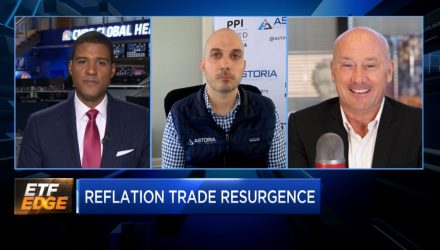On this week’s “ETF Edge,” things get started with CNBC’s Frank Holland addressing the wall of worry Wall Street faces with the rise of runaway inflation and a very hawkish Fed. With geopolitical tensions adding even more uncertainty, there’s plenty to discuss as far as the effect this could all have on global markets.
In relation to all of this, gold prices have shot up to their highest levels since before Thanksgiving, 2021. Additionally, while commodity ETFs suffered debt redemptions in 2021, they’ve already racked up over $6 billion in inflows this year, creating questions regarding how this latest turmoil factors into the commodities equation.
Discussing these topics and more, ETF Trends’ CEO Tom Lydon is on the panel, along with John Davi, founder and CIO of Astoria Portfolio Advisors. With ETFs still on pace to hit over $700 billion in 2022, there’s still a question of why there are continued, unabated inflows into equity funds.
For Lydon, noting the threat of inflation and rising interest rates, it’s clear why investors are being scared off. With that said, average financial advisors have had major construction changes in their portfolios.
“What they’re doing is paring back the traditional 60/40 and moving more out of fixed income and into areas like alternative income strategies, like dividends and options overlay strategies,” Lydon adds. “Most importantly, more and more advisors are allocating to commodities.”
Commodity Options Exist
Commodities are popping up all over, and some great diversified commodity options exist. As Lydon explains, rising rates can be detrimental to client portfolios, and advisors understand this. Investors have not seen this in a long time, but Lydon says that “they’re voting with their feet.”
Davi explains how investors can cope with elevated risk and how commodities make plenty of sense as they hedge against inflation. Tickers such as PDBC and BCI are broad-based commodity ETFs used by Astoria for this situation because they hedge against inflation, for one thing.
They also have attributes — positive skewness that will help diversify risk attributes. Plus, these funds provide a positive benefit. As Davi states, “This has to do with how commodity futures rule. Right now, there’s a benefit. Years in the past, they used to have cost.”
For more news, information, and strategy, visit ETF Trends.
